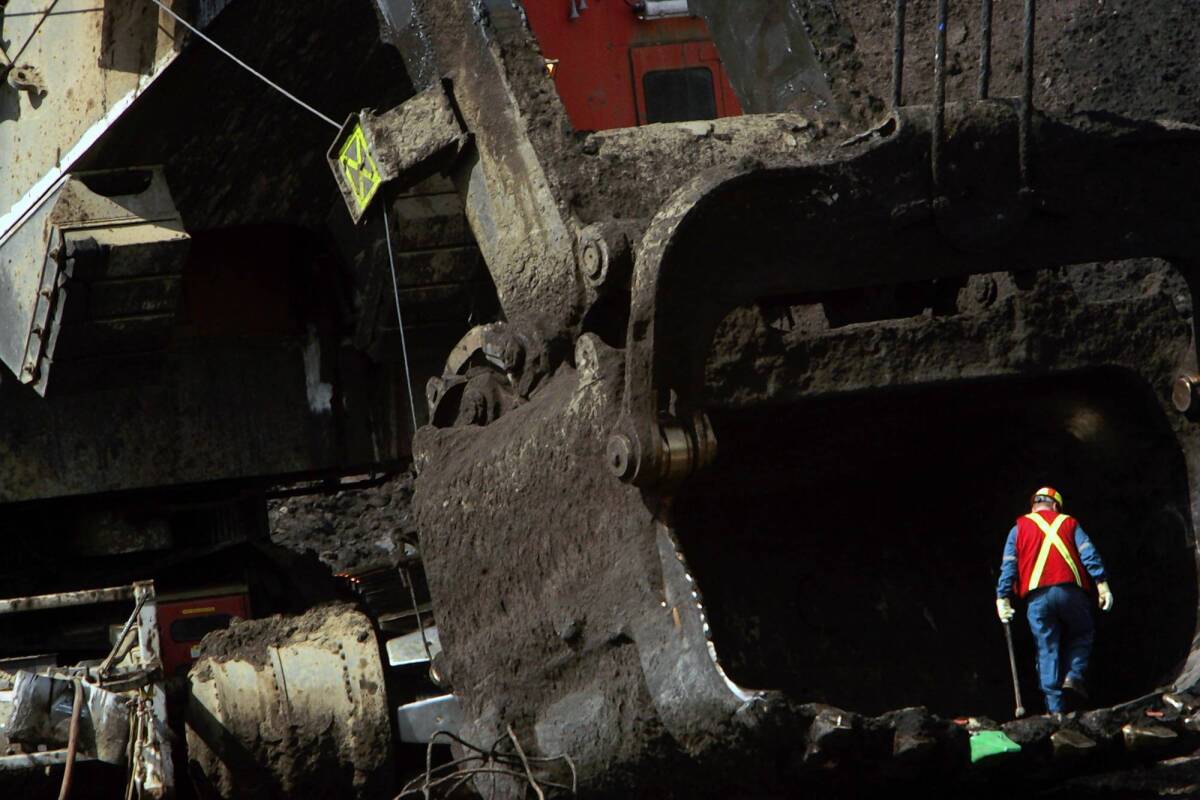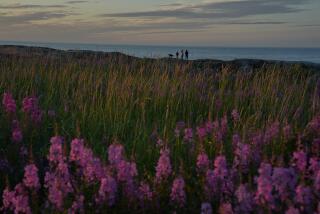In Canada’s Alberta province, oil sands boom is a two-edged sword

- Share via
FORT CHIPEWYAN, Canada — In the Cree language, the word “athabasca” means “a place where grass is everywhere.” Here in Alberta, the Athabasca River slices through forests of spruce and birch before spilling into a vast freshwater delta and Lake Athabasca.
But 100 miles upstream, the boreal forest has been peeled back by enormous strip mines, where massive shovels pick up 100 tons of earth at a time and dump it into yellow trucks as big as houses.
The tarry bitumen that is extracted is eventually shipped to refineries, many in the United States, to be processed into gasoline, diesel and other fuels. But the leftover polluted slurry remains in miles-long impoundments, some high above the banks of the river. Air cannons sound periodically to keep migratory birds from landing on the toxic ponds.
Oil sands production, as the procedure is called, is booming in northeastern Alberta. And it is expected to grow far larger if the Obama administration issues a federal permit for the Keystone XL pipeline from the province.
Debate in the U.S. over the pipeline has largely focused on whether the oil sands would contribute to climate change, or spill along the route. But in northeastern Alberta, the effect of the oil sands industry plays out in more complicated ways.
Oil sands are exploited by injecting high-pressure steam into the earth or by strip mining to extract the sticky bitumen, which is then washed away from clay and sand, swiftly heated and diluted with chemicals before being shipped to refineries.
The petroleum industry has funneled billions of dollars into Canada’s national, provincial and local economies and employs thousands of people in places with few other jobs. But the oil sands boom may also be polluting the air and water, and is stoking fear that it is damaging the health of those in its arc.
“From everything I hear from the indigenous peoples, their thinking seems to be ‘It’s a choice between whether we starve to death or are poisoned to death,’” said Dr. John O’Connor, a general practitioner who has worked here since 1993.
In Fort Chipewyan, a village of 1,100 people on the north shore of Lake Athabasca, cancer and autoimmune diseases such as lupus have taken a heavy toll on its mostly indigenous Cree, Dene and Metis population during the last 20 years. In 2009, the provincial government found that cancer rates here over a 12-year period were 30% higher than normal for such a small community (51 cancers in 47 individuals versus an expected 39 cancers).
Three weeks ago, government scientists told villagers that they had found high levels of mercury, a hazardous substance, in the eggs of migratory birds that nest downstream from oil sands production. Fishermen say pickerel and northern pike in the lake show bulging eyes and other deformities.
Three studies by independent scientists have shown rising concentrations of pollutants, including carcinogens, in waterways near Alberta’s oil sands production.
Industry officials and the Alberta government have long insisted that the chemicals detected in area waterways are naturally occurring, not the result of pollution.
They also say they are taking full safety precautions to protect communities tucked into a vast wilderness. Some of the indigenous people, known as the First Nations, have hunted and fished here for thousands of years.
The oil industry is funding a government-run system to monitor possible pollution. Reclamation efforts, meanwhile, can take years, if not decades. Of the thousands of acres mined during 40 years of oil sands extraction in Alberta, only 247 acres have been restored to land resembling unmined areas.
“We will be here another 50 to 60 years,” said Greg Stringham, vice president for oil sands for the Canadian Assn. of Petroleum Producers. “We’re very supportive of looking at the cumulative effect of what we do.”
Canada already is the largest exporter of crude to the United States, mostly from oil sands. Officials hope to increase production by 2030 to about 5 million barrels a day from the current 1.9 million barrels. Many of the world’s biggest oil companies hold leases to develop oil sands along the Athabasca River and other parts of eastern Alberta. Syncrude, Suncor and Shell already operate upstream from Fort Chipewyan.
The Keystone XL pipeline, the most efficient way to ship oil, is crucial to the effort. Some local residents fear the pipeline would accelerate development of the oil sands, and create additional pollution.
Beginning in the 1990s, says 71-year-old commercial fisherman “Big Ray” Ladouceur, he began catching fish with deformities from Lake Athabasca. The cause is unknown, but three peer-reviewed studies by university researchers since 2009 have sounded warnings about water pollution linked to oil sands development in Alberta.
One of those studies, which checked the Athabasca River for polycyclic aromatic hydrocarbons (PAHs), a carcinogen and component of bitumen, found them, with higher concentrations closer to mining and processing sites.
A January 2013 study on sediment cores from lakes near Alberta oil sand mines showed “a consistent story of increased contaminants and ecological change,” says Joshua Kurek, a postdoctoral fellow at Queen’s University in Ontario and lead author of the study. “Today our study lakes are very different compared to 50 years ago, and are on a path of unprecedented change.”
The government has exempted the oil industry from policies designed to protect wetlands, and it did not penalize the industry when it failed to meet environmental standards for its tailing ponds, according to government reports. Thousands of permits for oil sands extraction were issued last year, but only seven public hearings have been held.
Cal Dallas, Alberta’s minister of international and intergovernmental relations in Edmonton, the provincial capital, insisted that oversight is strong. “No one cares about the environment of our province more than the people who live there,” he said in an email.
“When we believe our strict environmental standards have been broken,” Dallas said, “we hold operators accountable through a variety of compliance actions.”
There were about 4,000 possible violations of environmental regulations from 1996 to 2012 related to oil sands extraction; Alberta authorities took enforcement actions in 37 cases, according to a July report, based on provincial records, by the environmental groups Treeline Ecological Research and Global Forest Watch Canada.
Yet with jobs scarce, some indigenous groups have made their peace with industry and the government.
The village at Fort MacKay, 100 miles upstream from Fort Chipewyan, is surrounded by mines and tailing ponds, with more on the way. For years, residents fought each oil sands project, and lost. But by the 1990s, they began to work with the industry to have a say in its expansion.
“It’s like sleeping next to a huge elephant,” said Jim Boucher, chief of the 560-person Fort McKay First Nation. “At the end of the day, we have to make the best of it.”
When the wind blows from the south, Fort MacKay smells of tar. But the village has reaped millions of dollars and is building a new youth center, church and amphitheater. Subdivisions are being built in the hills above the village; the driveways hold Cadillac Escalades and the backyards tepees.
In Fort Chipewyan, where a youth center downtown is named for the oil company Syncrude, there is fear about the effect of oil sands development and resignation about its inevitability.
Alice Rigney, 62, a lifelong resident, wonders whether her breast cancer a few years ago was related to mining pollutants, and she’d like to see the waste ponds cleaned up. But the semi-retired teacher of the Dene language says she’s also realistic: The wages the oil company is offering are too good for Canadians to turn down.
“I don’t think we can win. I don’t even know what winning looks like,” Rigney said. As she spoke, she looked out her kitchen window where whitecaps had formed on the lake. “This oil is just too important for the rest of Canada.”
More to Read
Sign up for Essential California
The most important California stories and recommendations in your inbox every morning.
You may occasionally receive promotional content from the Los Angeles Times.











